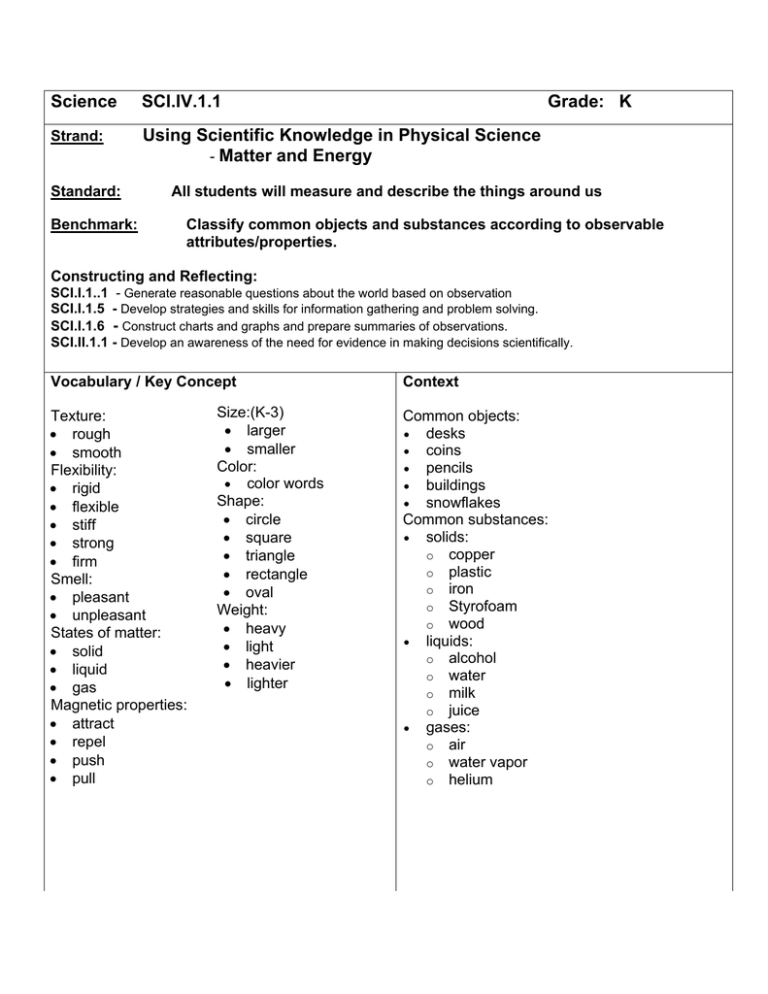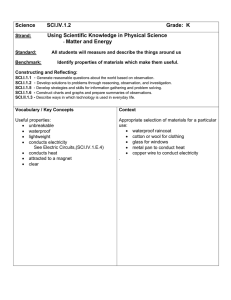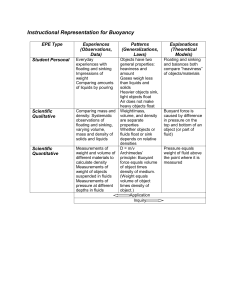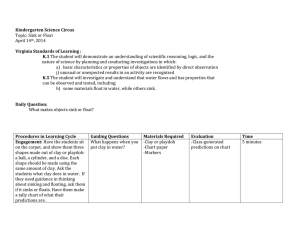Science SCI.IV.1.1 Grade: K
advertisement

Science SCI.IV.1.1 Strand: Using Scientific Knowledge in Physical Science - Matter and Energy Standard: Benchmark: Grade: K All students will measure and describe the things around us Classify common objects and substances according to observable attributes/properties. Constructing and Reflecting: SCI.I.1..1 - Generate reasonable questions about the world based on observation SCI.I.1.5 - Develop strategies and skills for information gathering and problem solving. SCI.I.1.6 - Construct charts and graphs and prepare summaries of observations. SCI.II.1.1 - Develop an awareness of the need for evidence in making decisions scientifically. Vocabulary / Key Concept Texture: • rough • smooth Flexibility: • rigid • flexible • stiff • strong • firm Smell: • pleasant • unpleasant States of matter: • solid • liquid • gas Magnetic properties: • attract • repel • push • pull Size:(K-3) • larger • smaller Color: • color words Shape: • circle • square • triangle • rectangle • oval Weight: • heavy • light • heavier • lighter Context Common objects: • desks • coins • pencils • buildings • snowflakes Common substances: • solids: o copper o plastic o iron o Styrofoam o wood • liquids: o alcohol o water o milk o juice • gases: o air o water vapor o helium Knowledge and Skills Students will • • Resources Coloma Resources: Describe common objects using physical/observable attributes and appropriate Newbridge Early Science Program, Big Books and Teachers Guide descriptive terms. Classify and sort common objects using • See, Hear, Taste, Touch and Smell physical characters/observable attributes. • Pasta Please The Five Senses Game Feel Mystery Box Amazing Science Book Series • Matter : Say it, Touch It Taste It, Smell It Instruction Benchmark Question: How do we describe the things around us? Focus Question: How are given objects alike and different? Children can describe and compare objects using the following centers/books/games: • • • • • Texture books Mystery box Sound Jars Tasting Parties Sorting Cards Assessment Teacher Observation Teacher Notes: http://www.misd.net/mibig/ Measure and describe the things around us. Elementary school children should be able to describe attributes of matter, which are qualitative, such as color, smell, size, and texture. Other attributes of matter are magnetic properties, such as attract and repel and density determined by sinking and floating. As students get more experience with qualitative aspects, they can move to quantitative attributes such as mass, weight, volume, and length. Students often have difficulty understanding the concept of matter. Research suggests that children often think that everything that exists is matter, including heat, light and electricity. They may also think that matter does not include liquids and gases. Mass and weight are two different ways to measure matter. Mass is a measure of the amount of matter in an object and a measure of the amount of inertia an object has. Mass does not change. Weight is dependent on location and can vary depending on where it is measured. Weight will be less if you are on the moon compared to the earth. Some students are confused about the difference between mass and weight. Mass is a property of all matter, weight depends on gravity. If there is no gravity, there can be no weight. Accepting weight as an intrinsic property of matter is difficult for some students. It is interesting to note that many sixth and seventh grade students still appear to think of weight as "felt weight". This leads them to think that if they cannot feel the weight then matter has no weight at all. Volume is another way to measure matter. Volume measures the amount of space an object occupies. Two objects can have the same mass, but very different volumes. Students frequently confuse mass and volume thinking that they describe the "amount of matter" and therefore are the same. Elementary students are often asked to identify floating and sinking objects. This poses problems for elementary students who misunderstand why objects sink or float. Density and buoyancy are complex ideas for students and are difficult to understand and teach at the elementary level. It is important to know that some students will think that objects sink in water because they are heavier than water. They also may think that objects float because they have air in them. In order to really understand floating and sinking, students must understand density. Objects sink if they are denser than the liquid and float if they are less dense than the liquid. Freighters are an excellent example of sinking and floating to begin to challenge students' ideas. Freighters are huge steel ships that are very heavy. Just the paint used to protect them can weigh tons. Yet large ships float because they displace their weight in water. Density is a ratio of mass to volume and is, therefore, a derived quantity. Density is a property of matter that does not change, regardless of the size of the sample. However, the density of an object can be altered by increasing or decreasing the volume of the object, while keeping the mass constant. For example, a hot air balloon rises when the air inside the balloon is heated because the process of heating causes the volume of air inside the balloon to increase and the density to decrease. Interestingly, students often confuse density and thickness, assuming that thick liquid is denser than thinner, less viscous liquids. Simple experiences with everyday objects can make it clear that this is not true. Oil is much thicker, more viscous, than water and yet is less dense than water. The thickness of a liquid is related to the strength of the intermolecular forces rather than spacing between molecules Measurement is an important skill that students begin developing in the earliest years. It begins with non-standard units of length, volume, and mass. An important concept is that any measurement is an estimation to the nearest unit being used. The measurement tool and the unit will be determined by the attribute being measured and the purpose of the measurement. Students must be able to select and use a balance to measure mass and measuring cups or graduated cylinders for volume. When measuring matter, students should understand that all measurements have error because one must always estimate the last reported digit. When measuring, a person must estimate one more place than the last number on the measuring device. All instruments have limitations on their ability to measure. Importantly, students in the middle school should be able to explain and use appropriate measurements to describe the properties of an object or substance. For example, they need to be able to determine if they should use mass or weight when finding density and they need to know when to use area and volume. Beginning in the elementary years, students should be able to identify the properties of materials that make them useful. This can be tied to simple ideas like strength or stretching and to more complex ideas like the conduction of heat and electricity. In the high school years, students are asked to analyze properties of common household and agricultural materials for risks and benefits.







